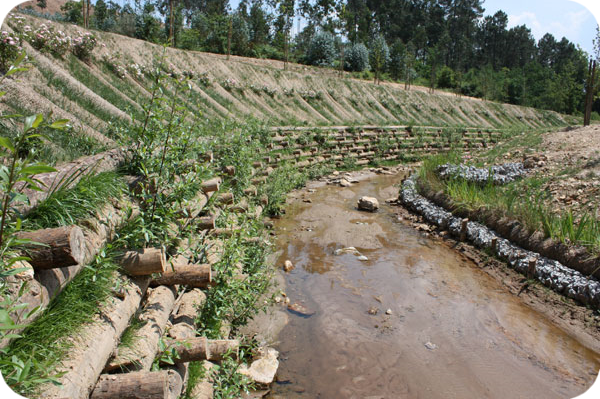Application: Bridges, canals, drainage, dykes, embankments, roads, footpaths, wastewater treatment plants
Description: A live crib wall is a three-dimensional structure created from untreated timbers, fill, and live cuttings. Layers of logs are interlocked with long branches protruding out between them. The logs are spiked together and anchored into the bank, with earth fill behind them to create a wall. The cuttings help tie the logs together and extend into the slope. They will sprout and develop a root mass that, in conjunction with the log structure, will armour the stream bank and protect it from erosion. The roots will eventually take over the structural purpose of the timbers. A live crib wall acts as a retaining wall and is effective for reducing erosion and streambank instability, especially on the outer bank of a stream-bend where the strongest currents are, and when reconstructing a streambank where extreme erosion has occurred. It can also be used to reduce the angle of a slope by building a low wall to protect the toe and grade the soil above it back at a gentler grade.
Contribution to climate resilience: Live crib walls prevent erosion, and can be used to reconstruct eroded banks by acting as a retaining wall and developing a root mass that reinforces the banks. By these means they increase the resilience of streambanks to extreme climatic events. Because they are constructed with local labour and materials, they require less energy to produce, are far more sustainable, and can often be constructed in a quicker timeframe than traditional civil engineering works.
Supplementary sources of information:
http://www.ctre.iastate.edu/erosion/manuals/streambank/live_cribwall.pdf
http://riparianhabitatrestoration.ca/575/livecribwalls.htm
https://water.ohiodnr.gov/portals/soilwater/pdf/stream/stfs17.pdf
http://www.ontariostreams.on.ca/PDF/OSRM/Tech15.pdf
http://www.fs.fed.us/t-d/pubs/htmlpubs/htm06232815/longdesc/fig3_68.htm
https://www.ieca.org/photogallery/2013photocontestwinners.asp
This resilience-building measure is sourced from the Water Resource Adaptation Guide (2019) published by the National Council for Sustainable Development at the Ministry of Environment in Cambodia. The full Guide is available to download at URL https://ncsd.moe.gov.kh/sites/default/files/2019-10/Water%20Resources%20Adaptation%20Guide_March%202019_En.pdf


